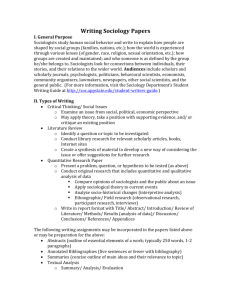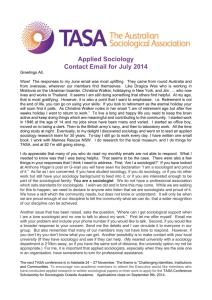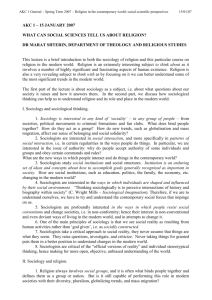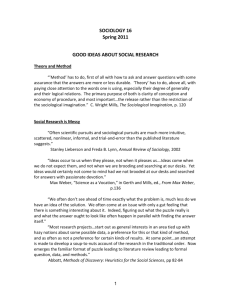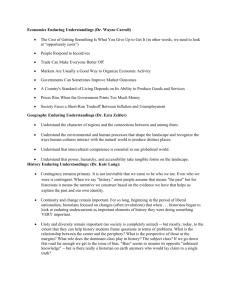Historical Sociology - Social Sciences And Humanities
advertisement
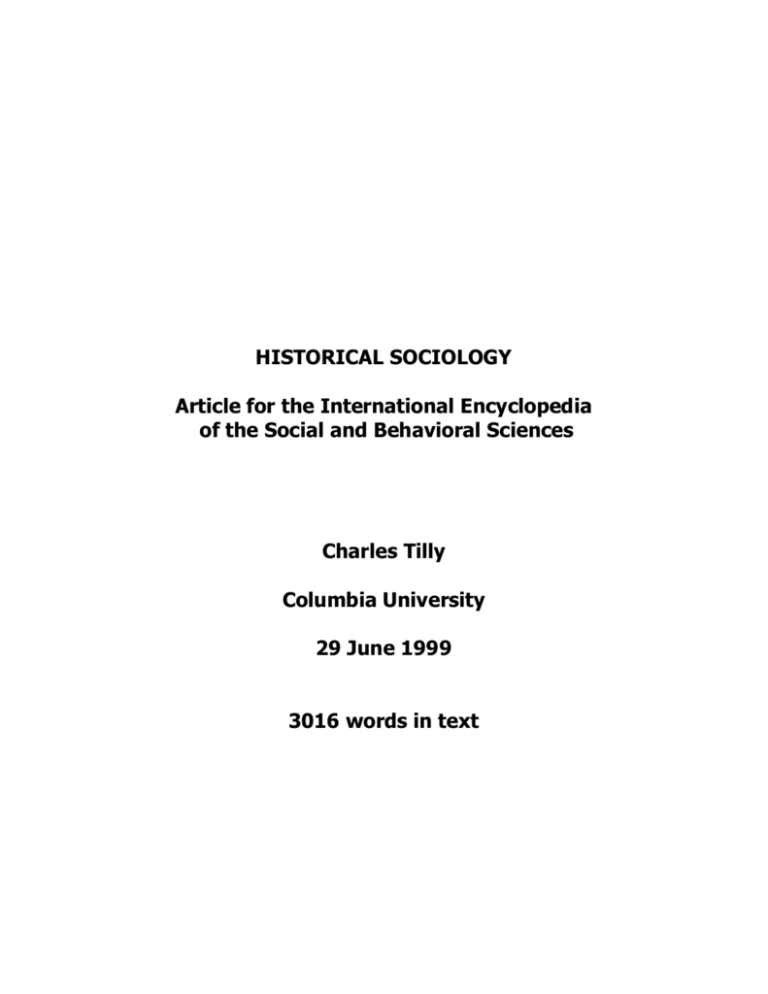
HISTORICAL SOCIOLOGY Article for the International Encyclopedia of the Social and Behavioral Sciences Charles Tilly Columbia University 29 June 1999 3016 words in text In 1844, Auguste Comte’s Lecture on the Positivist Outlook (Discours sur l’esprit positif) proposed the name “sociology” for the general science of humanity. In Comte’s vital vision, the hierarchy of sciences proceeded from mathematics at the base through astronomy, physics, chemistry, and biology to sociology at the summit. The maturing of basic sciences, he declared, now made it possible to construct the capstone science, sociology. In that defining moment for the sociological discipline, Comte’s conception of sociology included history, in fact consisted largely of analyzing the development of humanity through historical stages. From that point onward, however, professional history and professional sociology moved in very different directions. As the historical discipline organized later in the nineteenth century, professional historians came to specialize in particular times and places, for example modern Latin America or ancient China. This specialization built up clusters of expertise in the sources, languages, and institutions peculiar to different time-place settings, which in turn promoted collective research programs, debate among experts, education of newcomers, and exclusion of non-professionals from the historical guild. It also made syntheses of all human history in a Comtean style less attractive to ordinary historians. Meanwhile, sociologists divided up their own specialties mostly by structures and processes -- families, religions, industrialization, crime, and so on – and drew their evidence chiefly from observation of the countries they currently lived in. Sociologists’ historical essays divided among broad evolutionary and stage schemes, scattered examples illustrating general arguments, and sketchy prologues to studies of contemporary social phenomena. From these contrasting bases of intellectual organization sprang a number of mutual misunderstandings between historians and sociologists, including the sociologists’ common presumption that sociology is an explanatory, generalizing science and history a descriptive, particularizing science fated to provide raw material for sociologists’ generalizations. Historians returned the compliment by complaining that the present studied by sociologists was itself a narrow historical moment with no claim to universal significance, and that to pluck examples from history without thorough knowledge of the relevant sources, languages, and institutions courted intellectual disaster. Despite increasing separation between the disciplines, to be sure, occasional thinkers since Comte have ventured into grand syntheses that do not obviously belong to a single discipline. The ideas and accomplishments of Karl Marx and Max Weber transcend any single discipline. Grand syntheses addressing major historical questions have continued to appear in the twentieth century, with inquiries by Barrington Moore, Jr., Norbert Elias, Immanuel Wallerstein, and William H. McNeill overflowing disciplinary containers. Such works belong to the common heritage of history and the social sciences rather than to the narrower field of historical sociology. The idea of a distinct enterprise called historical sociology only formed during the twentieth century, as sociologists themselves began to distinguish sharply between Historical Sociology: 1 evidence coming from direct observation of the present and from indirect observation of the past. Historical sociologists sought to connect the two through serious investigation of other settings than the ones they lived in. During the twentieth century, historical sociology has differentiated into four rather different pursuits. We might call them social criticism, pattern identification, scope extension, and process analysis. All are legitimate, effective forms of sociological analysis. They differ substantially, however, in aims, procedures, and results. Historical social criticism reconstructs the past on the way to informing human choices in the present and future. It rests on the plausible assumptions that history contains a record of human successes and failures in dealing with problems persisting into the present; that if long-term trends exist, their causes are likely to continue; and that recent history limits what will happen next. Thus sociologists have created competing accounts of capitalism’s development as liberation, as oppression, or as something in between. Similarly, sociologists of the family review its history as a means of criticizing current trends and charting alternative futures. Although the description and criticism of contemporary social conditions preoccupied many nineteenth century sociologists, a large share of nineteenth century sociology consisted of historical social criticism – attempts to make better sense of current dilemmas and general directions of human development by situating the present in long, large social processes. Landmarks of nineteenth century social thought such as Karl Marx’s Capital, Max Weber’s Economy and Society or Ferdinand Tönnies’ Gemeinschaft und Gesellschaft embedded critiques of contemporary social life in vast historical syntheses. The tradition continues into our own time, as sociologists in the varied styles of Göran Therborn, Theda Skocpol, Jürgen Habermas, and Orlando Patterson contribute to current social criticism by reworking history. At its best, historical social criticism helps people act wisely and effectively in the present by displaying possible futures and paths to them. Historical social criticism overlaps with historical pattern identification, which it helped bring into being as a sociological specialty. Pattern identification searches for recurrent structures and sequences across time and space. Before World War II pattern identification often involved natural histories for large social aggregates, for example Pitirim Sorokin’s claim that each civilization passes through Ideational, Idealistic, and Sensate phases. (Sorokin’s analyses edged over into social criticism as he argued that western civilization had reached the last, corrupt stage of sensate culture, and that only spiritual renewal could save the West.) Pattern identification also took the form of natural histories for wars, revolutions, social movements, and other smaller-scale phenomena. After World War II, ideas of development and modernization sometimes followed the natural history model, but pattern-identifying historical sociologists generally moved toward the study of processes within countries or regions such as secularization, Historical Sociology: 2 industrialization, revolution, democratization, and population growth. Pattern identifiers usually seek to discover necessary and sufficient conditions for large, recurrent social transformations and/or to establish general sequences within those transformations. Much pattern identification consists of lining up comparable cases to determine whether they conform to the proposed pattern. Thus students of state formation as different in approach as Reinhard Bendix, Michael Mann, and Bernard Silberman collect historical evidence on central bureaucracies in multiple countries to see whether state bureaucratization regularly occurs in the course of economic expansion. At its best, historical pattern identification facilitates recognition of recurrent social processes with sufficient accuracy to permit intervention or anticipatory action. Scope extension applies techniques, models, or generalizations that sociologists have developed in studies of contemporary social life to historical situations. Demographers, for example, have often verified or refined models of fertility change developed initially to explain differences or short-range shifts in contemporary populations by examining longer runs of historical experience. Similarly, network analysts have sometimes extended ideas and techniques from the study of connections within currently observable populations to the reconstruction of changing connections within historical populations. Scope extension to historical cases can remain quite ahistorical or even anti-historical if the analyst disregards the time-space contexts of the social processes under investigation. But it also offers grounds for extensive collaboration between historians and sociologists, as well as for adaptation of sociological ideas by historians. Historians have, for example, conducted valuable investigations of social mobility in past time, examining evidence and time spans rarely available to their sociological cousins. Within disciplinary history, in fact, the special fields of social history, family history, demographic history, and economic history have grown up as interfaces with the social sciences, including sociology (Zunz 1985). In these fields, some work actually consists of sociological scope extension or its equivalent in relation to economics and political science. More takes up questions of general concern to historians by means of models, theories, or techniques grounded in social science – for example, using collective biography to trace changes in composition of the English gentry (Stone & Stone 1984). Scope extension has a mirror-image version. It consists of using historical evidence to challenge widespread suppositions of contemporary sociological analysis. The historical work of Viviana Zelizer offers an excellent case in point. Although her later writings about social meanings of money balance between scope extension and process analysis, her treatments of life insurance and valuation of children in the United States during the nineteenth and twentieth centuries demonstrate that economic transactions commonly portrayed as operating independently of culture -- or even to the detriment of culture -- actually rest on extensive, changing webs of shared understanding. It took extensive cultural work, for example, to make the insuring of human lives acceptable to Americans. At its best, scope extension accomplishes two distinct objectives: it corrects historical misconceptions as it broadens the domain of social scientific knowledge. Historical Sociology: 3 Process analysis examines how social interactions impinge on each other in space and time. Instead of considering space and time as additional variables, it presumes that space-time connections define social processes, and that social processes operate differently as a function of their placement in space and time. Sociologists studying urbanization, for example, have long sought to identify recurrent sequences and geographic arrangements of urban growth (pattern identification) and to determine whether explanations of urban growth that work reasonably well in contemporary capitalist countries also apply in non-capitalist history (scope extension). But they have also tried to determine how, why, and under what conditions large cities host highly differentiated occupations (process analysis). Although theorists have sometimes drawn their ideas on the subject from biological ecology or from the comparison of contemporary populations, this sort of process analysis is intrinsically historical. The analyst has no choice but to locate the processes under examination in time and space, then to ask how time and space affect them. Process analysts typically deny the premise of pattern identifiers: that large structures and processes repeat themselves in essentially the same form across history. Process analysts search instead for explanations of variation. A bold example comes from Janet Abu-Lughod’s study (1989) of the thirteenth century world system. Reacting to Immanuel Wallerstein’s claim that under European capitalist auspices the first economic world system formed during the fifteenth century and has prevailed ever since, Abu-Lughod examined connections among such farflung cities as Baghdad, Calicut, Canton, and Malacca three centuries earlier. She offered evidence of an active trading system, connected by both land and sea, of which Europe was then a peripheral appendage. Although Abu-Lughod’s analysis centers on the same sorts of mechanisms – generation of interaction by trade in high value-for-bulk commodities – as Wallerstein’s, it resets the questions. Abu-Lughod forces us to ask how and why a vast Asian-centered world system declined and a European-dominated system arose in its place. At its best, process analysis identifies causal mechanisms of broad scope as well as conditions that affect activation, interaction, and outcomes of those mechanisms (Hedström & Swedberg 1998). Social criticism, pattern identification, scope extension, and process analysis take somewhat different approaches to historical evidence. Social criticism relies almost entirely on selective use of existing historical accounts, often privileging earlier social criticism and social thought. Thus Jürgen Habermas’ Theory of Communicative Action reinterprets modern western history (especially that of Germany) via critiques of Karl Marx, Max Weber, Emile Durkheim, Talcott Parsons, and other thinkers, arriving at proposals for a critical theory to serve human liberation. In a more obviously historical vein, Manuel Castells’ The Information Age reviews changing information systems and identities in the world at large during the later twentieth century in order to identify choices and challenges facing today’s humanity. Castells’ sources include statistical Historical Sociology: 4 compilations and his own observations, but beyond general theory and the immediate past they center on works by historians and historical sociologists. By and large, pattern identifiers draw their evidence from historians’ syntheses, extracting comparable elements from the detail. In effect, they apply a uniform questionnaire to distinct historical episodes. Robert Wuthnow’s Communities of Discourse (1989) asks how ideological innovations take root by comparing the Protestant Reformation, the European Enlightment, and the formation of Marxist socialism. His implicit questionnaire’s broadest headings concern environmental conditions (for example, pace of economic growth), institutional contexts (e.g. extent of division within ruling elites), and action sequences (e.g. communication of new ideologies to broad audiences). Wuthnow draws evidence under these headings from wide reading of relevant histories, refashioning the evidence to establish uniformities – for example, the regular emergence not of a unitary belief but of competing ideologies, from which a political selection process singles out one or a few for predominance. Such implicit questionnaires discipline inquiry, but they also run two serious risks: of treating as equivalent events, institutions, and social relations that actually differ fundamentally, and of ignoring the causal connections of events, institutions, and social relations within their actual historical settings. Among historians, authors of textbooks and of grand narratives often proceed in a manner superficially resembling that of sociology’s pattern identifiers; they incorporate other historians’ detailed studies into large syntheses. Historians’ syntheses, however, typically hang together not through the detection of similar elements in distinct episodes but through the establishment of connections among episodes. Historians’ connections arise in different ways: from evolution of political or economic systems, from the impact of leaders, from transformation of the dominant culture, or perhaps from critical events such as creation of the first Chinese empires or the Russian revolutions of 1917. But on the whole historical synthesizers, unlike their sociological cousins, insist on connections in space and time. Within historical sociology, extensions of scope often employ procedures and sources resembling those of historical researchers. Historians make a rough distinction between primary and secondary sources. If the historical processes under study directly generated the sources, they qualify as primary; administrative correspondence, triumphal arches, artisans' tools, and contemporary portraits can all serve as primary sources. Secondary sources include later efforts to reconstruct what happened, especially efforts by other historians. The distinction must remain blurred, since chronicles, autobiographies, ambassadors’ dispatches to their home countries, newspaper accounts, and similar sources occupy a middle ground. Sociological scope extenders characteristically become familiar with the character of primary sources in their chosen historical eras even when their own analyses rely chiefly on secondary work by specialist historians. Thus historical demographers have Historical Sociology: 5 frequently compiled and analyzed registers of births, deaths, and marriages for themselves in search of clues concerning determinants of changes in fertility, mortality, or nuptiality (Willigan & Lynch 1982). As historical demography illustrates, sociologists working with a recognized body of historical sources are more likely than their historical brethren to center their analyses on models, methods, or arguments drawn directly from contemporary studies of ostensibly similar phenomena. Not all sociological scope extenders, however, apply formal models to the past. In common with their cousins in anthropology, for example, sociologists with historical orientations have often engaged in retrospective ethnography, taking the questions and procedures of local community studies back in time. In a pioneering work of historical sociology, English Villagers of the Thirteenth Century (1941), George Caspar Homans reconstructed the organization of different sorts of villages much as contemporary observers of communities were reconstructing the organization of villages in the Americas, Europe, and elsewhere. Homans substituted historical records for the interviews and first hand observation of community ethnographers. Recently, Don Kalb (1997) has adopted retrospective ethnography to follow transformations of class, family structure, and politics in industrial North Brabant during the nineteenth and twentieth centuries. Both Homans and Kalb made simultaneous contributions to sociologists’ and historians’ treatments of their subject matters. Of our four varieties of historical sociology, process analyses engage sociologists most directly in thinking about history as history – that is, as the embedding of human action in time and space. Here the distinction between primary and secondary sources begins to dissolve, and the sources rarely come ready made. Reconstructing processes by which science changes, for example, engages historical sociologists of science in looking simultaneously at organizational settings, individual biographies, interpersonal networks, contested bodies of thought, and connections among all of them. No simple exportation of contemporary models into the past will accomplish that sort of synthesis. Process analysts concentrate on connections among events, which means that, whether explicitly or implicitly, they typically construct matrices having multiple dimensions: time, place, type of event, form of connection, and so on. Wherever they find their historical evidence, then, process analysts snip, splice, paste, and rearrange it extensively. John Markoff’s Abolition of Feudalism, a case in point, recasts local statements of grievances from the France of 1789 into regional and class distributions of demands, then integrates a vast catalog of peasant actions into an analysis of popular mobilization as a dynamic process during the early Revolution. Similarly, Roberto Franzosi pursues a search for causes of industrial conflict by threading his way among aggregate Italian strike data between 1950 and 1980, increasingly refined econometric models, and close examination of shifts in institutional and political settings. In both cases, the analysts ended up showing that when and where political processes occurred significantly affected how they occurred, and what results they produced. Historical Sociology: 6 As sociology and history now operate, relatively little flow occurs between sociologists’ historical social criticism and adjacent fields of historical endeavor. The same is generally true of historical pattern identification. Neither endeavor attracts much attention from historians. Nor do sociologists respond readily to historians’ efforts along similar lines. More ideas flow in both directions across the boundaries of scope extension, but the chief effect of collaboration between sociologists and historians at that interface has been to create a series of specialized sub-disciplines: historical demography, demographic history, and their equivalents. As a result, sociologists and historians at large remain woefully ignorant of each other’s sources, methods, models, ideas, and discoveries. In the zone of process analysis, however, we find intense interaction between historians and sociologists. We also find sharp disagreement. Questions of epistemology, ontology, and method align practitioners with competing answers to such questions as “What is an event?”, “Can we detect causes in history?”, “Do all social processes result from individual choices?” and “Do organizations really exist?” Debates over such issues roil current discussions of state formation, population change, revolution, capitalist development, and other large processes (see, e.g., Abbott 1994, 1998, Bates 1998, Hamilton 1996, McDonald 1996, Steinmetz 1999). That is as it should be; where relations among historical researchers run harmoniously, we should fear that they have worked out a comfortable but ultimately fruitless division of labor. We can take some satisfaction from noticing that the deep epistemological, ontological, and methodological divisions of our time do not pit historians against sociologists, but cut across the once-forbidding frontier between history and sociology. Historical Sociology: 7 REFERENCES Abbott, Andrew (1994): "History and Sociology: The Lost Synthesis," in Eric Monkkonen, ed., Engaging the Past. The Uses of History across the Social Sciences. Durham: Duke University Press. (1998): "The Causal Devolution," Sociological Methods and Research 27: 148-181. Abu-Lughod, Janet (1989): Before European Hegemony. New York: Oxford University Press. Bates, Robert H. et al. (1998): Analytical Narratives. Princeton: Princeton University Press. Bendix, Reinhard (1964): Nation-Building and Citizenship. New York: Wiley. Castells, Manuel (1996-1998): The Information Age: Economy, Society, and Culture. Oxford: Blackwell. 3 vols. Comte, Auguste (1963): Discours sur l”esprit positif. Paris: Union Générale d’Editions. First published in 1844. Elias, Norbert (1978, 1982): The Civilizing Process. New York: Pantheon. 2 vols. German edition first published in 1939. Franzosi, Roberto (1995): The Puzzle of Strikes. Class and State Strategies in Postwar Italy. Cambridge: Cambridge University Press. Habermas, Jürgen (1984, 1987): The Theory of Communicative Action. Boston: Beacon. 2 vols. German original first published in 1981. Hamilton, Richard F. (1996): The Social Misconstruction of Reality. Validity and Verification in the Scholarly Community. New Haven: Yale University Press. Hedström, Peter & Richard Swedberg (1998): eds., Social Mechanisms. An Analytical Approach to Social Theory. Cambridge: Cambridge University Press. Homans, George Caspar (1941): English Villagers of the Thirteenth Century. Cambridge: Harvard University Press. Kalb, Don (1997): Expanding Class. Power and Everyday Politics in Industrial Communities, The Netherlands, 1850-1950. Durham: Duke University Press. Mann, Michael (1986, 1993): The Sources of Social Power I. A History of Power from the Beginning to A.D. 1760; II. The Rise of Classes and Nation-States, 1760-1914. Cambridge: Cambridge University Press. Historical Sociology: 8 Markoff, John (1996): The Abolition of Feudalism. Peasants, Lords, and Legislators in the French Revolution. University Park: Pennsylvania State University Press. Marx, Karl (1970-1972): Capital. A Critique of Political Economy. London: Lawrence & Wishart. 3 vols. German version first published in 1867-1894. McDonald, Terrence J. (1996): ed., The Historic Turn in the Human Sciences. Ann Arbor: University of Michigan Press. McNeill, William H. (1982): The Pursuit of Power. Technology, Armed Force and Society since A.D. 1000. Chicago: University of Chicago Press. Moore, Barrington, Jr. (1966): Social Origins of Dictatorship and Democracy. Boston: Beacon. (1979): Injustice. The Social Bases of Obedience and Revolt. White Plains, N.Y.: M.E. Sharpe. Patterson, Orlando (1991): Freedom. Vol. I: Freedom in the Making of Western Culture. New York: Basic Books. Silberman, Bernard S. (1993): Cages of Reason. The Rise of the Rational State in France, Japan, the United States, and Great Britain. Chicago: University of Chicago Press. Skocpol, Theda (1979): States and Social Revolutions. A Comparative Analysis of France, Russia, and China. Cambridge: Cambridge University Press. (1992): Protecting Soldiers and Mothers. The Political Origins of Social Policy in the United States. Cambridge: Harvard University Press. (1998): ed., Democracy, Revolution, and History. Ithaca: Cornell University Press. Sorokin, Pitirim A. (1962): Social and Cultural Dynamics. 4 volumes. New York: Bedminster. First published 1937-1941. Steinmetz, George (1999): ed., State/Culture. State-Formation after the Cultural Turn. Ithaca: Cornell University Press. Stone, Lawrence & Jeanne C. Fawtier Stone (1984): An Open Elite? England 1540-1880. Oxford: Clarendon Press. Therborn, Göran (1995): European Modernity and Beyond. The Trajectory of European Societies, 1945-2000. London: Sage. Tönnies, Ferdinand (1957): Community and Society. East Lansing: Michigan State University Press. German version first published in 1887. Historical Sociology: 9 Wallerstein, Immanuel (1974-1989): The Modern World System. New York: Academic Press. 3 vols. Weber, Max (1968): Guenther Roth & Claus Wittich, eds., Economy and Society. 3 vols. New York: Bedminster Press. German version first published in 1922. Willigan, J. Dennis & Katherine A. Lynch (1982): Sources and Methods of Historical Demography. New York: Academic Press. Wuthnow, Robert (1989): Communities of Discourse. Ideology and Social Structure in the Reformation, the Enlightenment, and European Socialism. Cambridge: Harvard University Press. Zelizer, Viviana (1979): Morals and Markets. The Development of Life Insurance in the United States. New York: Columbia University Press. (1985): Pricing the Priceless Child. The Changing Social Value of Children. New York: Basic Books. (1994): The Social Meaning of Money. New York: Basic Books. Zunz, Olivier (1985): ed., Reliving the Past. The Worlds of Social History. Chapel Hill: University of North Carolina Press. Historical Sociology: 10
